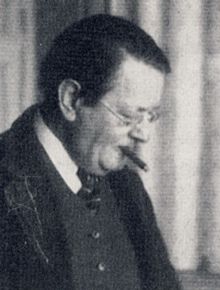Cyrillus Johansson
Cyrillus Johansson (born July 9, 1884 in Gävle , † May 20, 1959 in Lidingö ) was a Swedish architect .
Career
Cyrillus Johansson put his degree in 1905 at the Chalmers University of Technology in Gothenburg , and three years later at the Art Academy in Stockholm . Then he founded his architecture office and at the same time taught urban planning at the art college.
Johansson followed the style of north German brick architecture at an early stage and in principle stuck to it until the 1950s. His early works include a larger house (1910) in Stockholm's old town and the water towers of Ljusdal (1916) and Waxholm (1923). His sophisticated brick architecture was reflected in two private villas in the Diplomatstaden (Villa Wickström and Villa Bonde, both 1925) and at Centrumhuset (1931) on the corner of Kungsgatan / Sveavägen in Stockholm. Johansson brought Chinese-inspired architecture to some of his works, for example at the Värmlands Museum in Karlstad (1926), where the sturdy brick building was crowned by a rambling pagoda roof .
Johansson also made a name for himself as an industrial architect. Here are mentioned; the buildings for the Stockholm cotton mill (1916) and for the vin and fuel centers (1920) and the Årstabrücke (1924), which with its 19 concrete arches is reminiscent of an ancient aqueduct . Other works include the Ludvika Town Hall (1934) and the Nikkaluokta Chapel (1942), which are strongly reminiscent of the Kiruna Church by fellow architect Gustaf Wickman . Johansson designed numerous workers' apartments in various small towns in Sweden. One of his last works was the church of Stora Essingen (1959).
Pictures of some of his works
Town hall in Ludvika , 1937
Literature and source
- Svensk arkitektur, 1640-1970 , Byggförlaget, Stockholm 1986. ISBN 91-85194-67-0
Web links
| personal data | |
|---|---|
| SURNAME | Johansson, Cyrillus |
| BRIEF DESCRIPTION | Swedish architect |
| DATE OF BIRTH | July 9, 1884 |
| PLACE OF BIRTH | Gävle |
| DATE OF DEATH | May 20, 1959 |
| Place of death | Lidingö |





